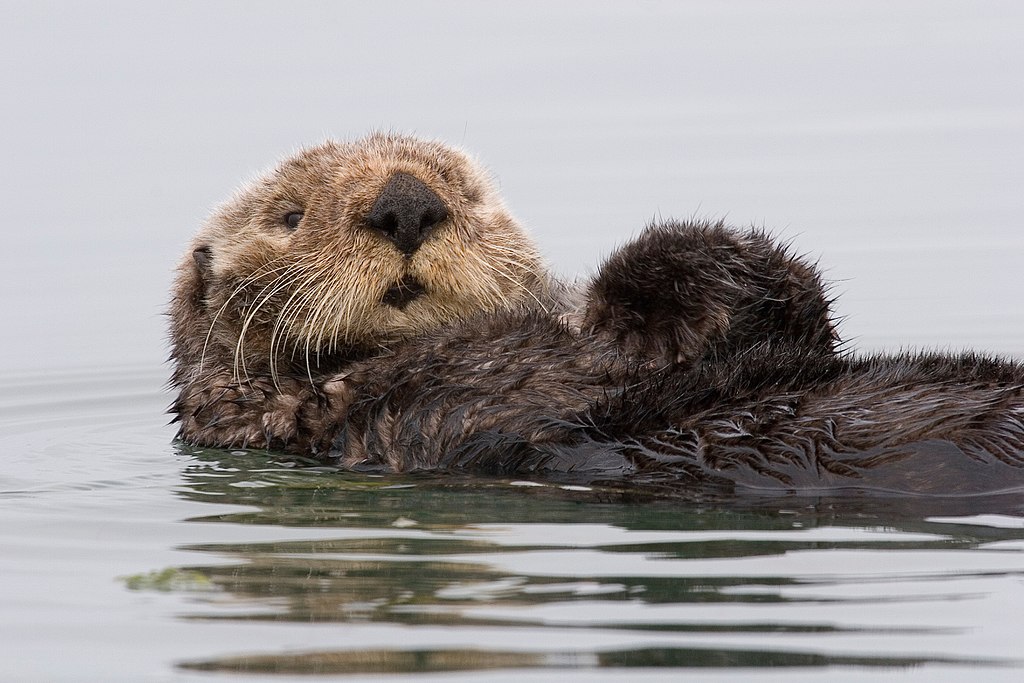By Hal Michael – The Sea Otter is a charismatic animal that “everybody” wants to take home and cuddle. Luxurious coat, dexterous paws, living close to shore, and easily observed all add to the mystique. Couple this with many positive benefits to an ecosystem and who could not like them?

Originally, the Sea Otter ranged from northern Japan, across the Aleutian Islands and now the eastern Pacific Coast to mid Baja California. They may have ranged further south along the Asian coast, but their pelts were highly valued, and those areas were settled long before the more northern and eastern parts of the range. During the late 1700s through the 1800s otters were heavily hunted for their pelts. So much so that by the beginning of the 20th Century, they occurred only in small scattered locations from central California around to Japan.
At that time, full protection was offered in the North Pacific and numbers slowly increased. This was also accompanied by attempts to transplant otters from areas of abundance to sites where they had been extirpated. Some worked, some didn’t. The current range in central California is from just north of Monterey Bay south to the Channel Islands. There are a few in Oregon and a few off of Baja. In Washington they range from about Kalaloch to Neah Bay, and then in northern BC through SE Alaska and the Aleutians. Finally, there are herds in northern Japan and Kamchatka/Siberia. They are now relatively easy to find within the centers of their range as they are generally close to shore and easily observed. In Washington, the north coast and outer reaches of the Straits are the best places to look.
Although sea otters are primarily associated with outer coasts, there apparently was a large population in San Francisco Bay in the 1700s and into the early 1800s as they were hunted as part of the Russian operations based out of Fort Ross. Coupled with their invasion of Monterey Bay and sloughs, it is possible that many of the larger bays along the Pacific coast such as Grays Harbor and Willapa could become home to otters in the future. At the same time, should Sea Otters invade bays and sloughs, they might come into conflict with the River Otter. The River Otter, while normally found in freshwater, does occur in salt and is often misidentified as Sea Otters here in Puget Sound.
The Sea Otter is a big weasel but also the smallest marine mammal. They differ from other marine mammals by lacking an insulating blubber layer. As such, they combine a very dense coat with a ravenous appetite. They eat about a third of their weight a day, which is a lot of shellfish. The fact that they eat so much leads to one of their most well-known ecological “benefits”. Their consumption of kelp grazers such as abalone and sea urchin leads to the restoration of kelp forests which leads to the restoration of kelp-dependent fish populations. This comes, though, at the expense of the abalone, urchins, and other grazers that humans like to eat.
In the Monterey Bay area, Sea Otters’ taste for crab has resulted in their exerting a significant control on invasive Green Crabs and burrowing crabs in estuaries. So much so, that the estuarine habitat is recovering. The Green Crab is currently found in parts of Washington where efforts are being made to eradicate them. If eradication is unsuccessful then control by otters may be an option. It should be noted though, that the otters like crab, and so would also eat the Red Rock and Dungeness crabs as avidly as Greens.
The conflict between people and otters has been going on for hundreds, if not thousands, of years. Middens in Alaska show that indigenous peoples’ diet shifted with the removal of otters. The conflict has further manifested itself along the California coast where the possible reintroduction of otters would likely wipe out the existing fisheries of abalone and urchins. There is vocal opposition to the otters as they would ultimately displace/unemploy fishermen. Otters have already eliminated fishable populations of Pismo Clams in some parts of California. While we don’t have Pismos as our surf clam in Washington, we do have Razor Clams, which the otters do eat. In addition, the otters are vulnerable to viruses that are transmitted from domestic cats to the waterways.
Therein lies the problem. Expansion of the otter populations will come at a direct cost of some resources that we like to consume and to the manner in which we live. Restoration will also benefit other resources that we like. The recovery of sea otters to their whole original range will create some interesting conflicts as to what resources we want.
Currently there are plenty of accessible areas up and down the Pacific Coast where otters can be seen in conjunction with other iconic animals such as Elephant Seals, California Condors, Grey Whales, Northern Fur Seals, and the like. We might even see one of their primary predators, the White Shark. We have seen otters around the rocks offshore from the Kalaloch Lodge and at numerous places on the California Coast from Ano Nuevo State Park south to San Simeon.







